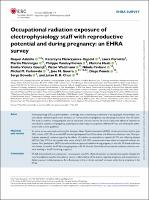| dc.contributor | Vall d'Hebron Barcelona Hospital Campus |
| dc.contributor.author | Adeliño, Raquel |
| dc.contributor.author | Malaczynska-Rajpold, Katarzyna |
| dc.contributor.author | Perrotta, Laura |
| dc.contributor.author | Manninger, Martin |
| dc.contributor.author | Vanduynhoven, Philippe |
| dc.contributor.author | Nesti, Martina |
| dc.date.accessioned | 2023-08-24T08:22:54Z |
| dc.date.available | 2023-08-24T08:22:54Z |
| dc.date.issued | 2023-08-02 |
| dc.identifier.citation | Adeliño R, Malaczynska-Rajpold K, Perrotta L, Manninger M, Vanduynhoven P, Nesti M, et al. Occupational radiation exposure of electrophysiology staff with reproductive potential and during pregnancy: an EHRA survey. Europace. 2023 Aug 2;25(9):euad216. |
| dc.identifier.issn | 1532-2092 |
| dc.identifier.uri | https://hdl.handle.net/11351/10148 |
| dc.description | Salut ocupacional; Embaràs; Exposició a la radiació |
| dc.language.iso | eng |
| dc.publisher | Oxford University Press |
| dc.relation.ispartofseries | EP Europace;25(9) |
| dc.rights | Attribution-NonCommercial 4.0 International |
| dc.rights.uri | http://creativecommons.org/licenses/by-nc/4.0/ |
| dc.source | Scientia |
| dc.subject | Radiació - Efectes fisiològics |
| dc.subject | Electrofisiologia |
| dc.subject.mesh | Cardiac Electrophysiology |
| dc.subject.mesh | Radiation Exposure |
| dc.title | Occupational radiation exposure of electrophysiology staff with reproductive potential and during pregnancy: an EHRA survey |
| dc.type | info:eu-repo/semantics/article |
| dc.identifier.doi | 10.1093/europace/euad216 |
| dc.subject.decs | electrofisiología cardíaca |
| dc.subject.decs | exposición a la radiación |
| dc.relation.publishversion | https://doi.org/10.1093/europace/euad216 |
| dc.type.version | info:eu-repo/semantics/publishedVersion |
| dc.audience | Professionals |
| dc.contributor.organismes | Institut Català de la Salut |
| dc.contributor.authoraffiliation | [Adeliño R] Unitat d’Arrítmies, Servei de Cardiologia, Vall d’Hebron Hospital Universitari, Barcelona, Spain. Cardiology-Heart Rhythm Management Department, Clinique Pasteur, Toulouse, France. [Malaczynska-Rajpold K] Royal Brompton & Harefield Hospitals, Guy’s & St Thomas (NHS Foundation Trust), London, UK. [Perrotta L] Arrhythmia Unit, Department of Cardiothoracovascular Medicine, Careggi University Hospital, Florence, Italy. [Manninger M] Division of Cardiology, Department of Medicine, Medical University of Graz, Graz, Austria. [Vanduynhoven P] Department of Cardiology, Arrhythmia Clinic, Algemeen Stedelijk Ziekenhuis Aalst, Aalst, Belgium. [Nesti M] Arrhythmia Unit, Fondazione Toscana Gabriele Monasterio, Pisa, Italy |
| dc.identifier.pmid | 37498147 |
| dc.identifier.wos | 001042320100001 |
| dc.rights.accessrights | info:eu-repo/semantics/openAccess |


